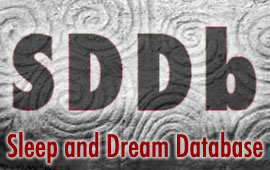 Here’s a good example of how to use the word search function of the Sleep and Dream Database. It focuses on “visitation dreams,” i.e., dreams in which people who are dead appear as if alive. These vivid and highly memorable dreams have been reported in cultures all over the world, in many periods of history. People today still experience visitation dreams with remarkable frequency (1). As part of research I’m doing for a new book, I want to learn more about the basic patterns in visitation dreams. I’m especially interested in their social and emotional aspects. My hypothesis, based on cross-cultural evidence and the results of a 2007 content analysis study I did of mystical dreams (2), is that visitation dreams tend to be positive experiences, characterized by friendly interactions and low negative emotions.
Here’s a good example of how to use the word search function of the Sleep and Dream Database. It focuses on “visitation dreams,” i.e., dreams in which people who are dead appear as if alive. These vivid and highly memorable dreams have been reported in cultures all over the world, in many periods of history. People today still experience visitation dreams with remarkable frequency (1). As part of research I’m doing for a new book, I want to learn more about the basic patterns in visitation dreams. I’m especially interested in their social and emotional aspects. My hypothesis, based on cross-cultural evidence and the results of a 2007 content analysis study I did of mystical dreams (2), is that visitation dreams tend to be positive experiences, characterized by friendly interactions and low negative emotions.
Can I put that hypothesis to an empirical test? Can I push the analysis of visitation dreams to a deeper level of detail and identify additional recurrent features?
The SDDb word search function makes this kind of research easier to pursue than ever before. There’s a new set of dreams in the database, Demographic Survey 2012, which includes a question about visitation dreams. On the word search page I scrolled down the list of constraint values to harris_2012:Q1030, Visitation Dream, and selected it. I then selected “Female” from the top line of the constraint value list. I clicked on “Word Search” again, and entered “25” in the Min Words box under Limit Response Length. When I clicked “Perform Search” I had a set of 221 reports from women of visitation dreams of 25 or more words in length. When I repeated this procedure and selected “Male” instead of “Female,” I had a set of 96 reports from men of visitation dreams of 25 or more words in length.
For both the Female and Male sets I searched for all 7 Word Classes and 40 Word Categories, one class or category at a time. It took about 20 minutes to generate these figures.
The results both confirm and extend my initial hypothesis. The visitation dreams have many more friendly than physically aggressive social interactions, and generally low proportions of negative emotions (3). That’s a solid confirmation of previous findings, with some additional details to fill out the picture:
— The overwhelming majority of characters in the visitation dreams are elder family members. For women, the most frequently used family character words are grandmother, mother, and father. For men, the most used words are father and dad.
— Other than vision, speech, and some mention of intensity, these dreams have very few other elements of content: low non-visual perception, low colors, low emotions, low cognition, low nature, low non-family characters, low non-friendly social interactions, and virtually no culture references.
This quick exercise in using the SDDb’s word search function has taught me several things. Visitation dreams do seem to be mostly positive experiences. They very often include elder family members, i.e. well-known and personally intimate characters with whom the dreamer speaks and has friendly social interactions. Evidently few other details matter; the dreamer’s focus is squarely on the appearance of the person who is dead but appears as if alive. There may be some gender differences in which particular family characters show up most frequently, but the basic patterns of content emerge clearly in both the women’s and men’s reports.
I’m sure I’ll find many more recurrent themes once I read through the dream narratives. But already, after just a few minutes of statistical analysis, I have a good overview of the dreams that gives me an empirical context for highlighting further subtleties of significance.
Notes:
(1) In American Dreamers I cite a 2007 survey of 705 American adults that found 38% of the participants had experienced a visitation dream at least once in their lives (p. 32).
(2) “Mystical Dreaming: Patterns in Form, Content, and Meaning” (2009), Dreaming 19(1): 30-41.
(3) These two sets are not perfect matches for comparison with the SDDb Baselines, since they include all reports of 25+ words, whereas the SDDb Baselines are for reports of 25-49 words and 50-300 words. But the baselines can still be useful in evaluating the broad patterns of the visitation dreams.





